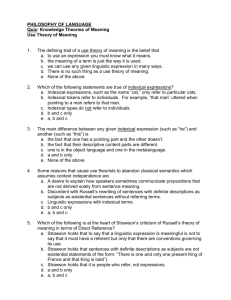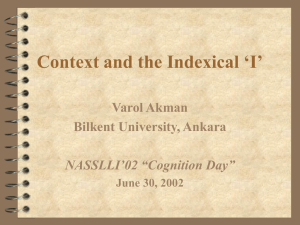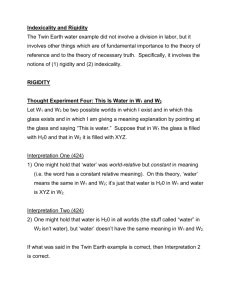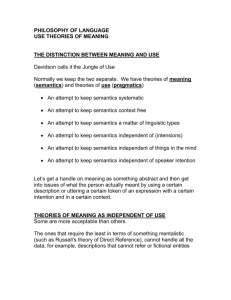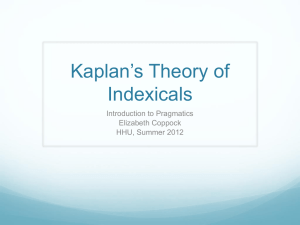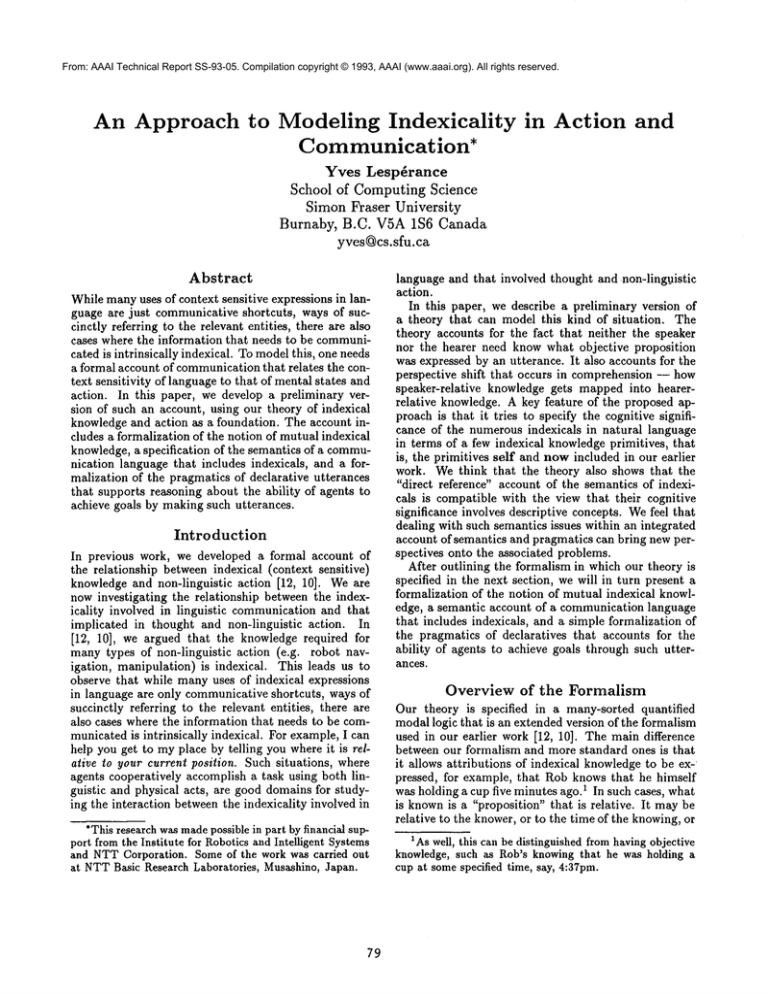
From: AAAI Technical Report SS-93-05. Compilation copyright © 1993, AAAI (www.aaai.org). All rights reserved.
An Approach to Modeling Indexicality
Communication*
in Action
and
Yves Lesp6rance
School of Computing Science
Simon Fraser University
Burnaby,
B.C. V5A 1S6 Canada
yves@cs.sfu.ca
Abstract
While manyuses of context sensitive expressions in language are just communicative shortcuts, ways of succinctly referring to the relevant entities, there are also
cases where the information that needs to be communicated is intrinsically indexical. To modelthis, one needs
a formal account of communicationthat relates the context sensitivity of language to that of mental states and
action. In this paper, we develop a preliminary version of such an account, using our theory of indexical
knowledge and action as a foundation. The account includes a formalization of the notion of mutual indexical
knowledge, a specification of the semantics of a communication language that includes indexicals, and a formalization of the pragmatics of declarative utterances
that supports reasoning about the ability of agents to
achieve goals by making such utterances.
Introduction
In previous work, we developed a formal account of
the relationship between indexical (context sensitive)
knowledge and non-linguistic action [12, 10]. Weare
now investigating the relationship between the indexicality involved in linguistic communication and that
implicated in thought and non-linguistic action. In
[12, 10], we argued that the knowledge required for
many types of non-linguistic action (e.g. robot navigation, manipulation) is indexical. This leads us to
observe that while many uses of indexical expressions
in language are only communicative shortcuts, ways of
succinctly referring to the relevant entities, there are
also cases where the information that needs to be communicated is intrinsically indexical. For example, I can
help you get to myplace by telling you where it is relative lo your curren~ posilion. Such situations, where
agents cooperatively accomplish a task using both linguistic and physical acts, are good domains for studying the interaction between the indexicality involved in
*Thisresearch was madepossible in part by financial support from the Institute for Robotics and Intelligent Systems
and NTTCorporation. Someof the work was carried out
at NTTBasic Research Laboratories, Musashino, Japan.
79
language and that involved thought and non-linguistic
action.
In this paper, we describe a preliminary version of
a theory that can model this kind of situation.
The
theory accounts for the fact that neither the speaker
nor the hearer need know what objective proposition
was expressed by an utterance. It also accounts for the
perspective shift that occurs in comprehension -- how
speaker-relative
knowledge gets mapped into hearerrelative knowledge. A key feature of the proposed approach is that it tries to specify the cognitive significance of the numerous indexicals in natural language
in terms of a few indexical knowledgeprimitives, that
is, the primitives self and nowincluded in our earlier
work. We think that the theory also shows that the
"direct reference" account of the semantics of indexicals is compatible with the view that their cognitive
significance involves descriptive concepts. Wefeel that
dealing with such semantics issues within an integrated
account of semantics and pragmatics can bring new perspectives onto the associated problems.
After outlining the formalism in which our theory is
specified in the next section, we will in turn present a
formalization of the notion of mutual indexical knowledge, a semantic account of a communication language
that includes indexicals, and a simple formalization of
the pragmatics of declaratives that accounts for the
ability of agents to achieve goals through such utterances.
Overview
of the Formalism
Our theory is specified in a many-sorted quantified
modal logic that is an extended version of the formalism
used in our earlier work [12, 10]. The main difference
between our formalism and more standard ones is that
-~
it allows attributions of indexical knowledgeto be ex
pressed, for example, that Rob knows that he himself
was holding a cup five minutes ago.1 In such cases, what
is knownis a "proposition" that is relative. It maybe
relative to the knower, or to the time of the knowing, or
1 Aswell, this can be distinguished fromhaving objective
knowledge, such as Rob’s knowing that he was holding a
cup at somespecified time, say, 4:37pm.
perhaps to other aspects of the context. To handle this,
our language includes two special terms: self, which denotes the current agent, and now, which denotes the
current time; we call these terms primitive indexicais.
Note that self and now are not intended to be formal counterparts of similarly sounding English words
and often behave quite differently from any such words.
Non-logical (domain-dependent) symbols may also depend on the current agent and time for their interpretation, for example, 3xHoLDING(x)may express the fact
that the current agent is currently holding something
-- we say that such symbols are non-primitive indezicals. Our semantics handles this by interpreting terms
and formulas with respect to indices, which consist of a
possible-world (modeling the objective circumstances),
an agent and a time (modeling the context).
The language includes terms of several different sorts.
There are terms for ordinary individuals (as usual -sort i), agent terms (sort a), temporal terms (sort
and action terms (sort d). For each sort, there are both
variables and function symbols (i.e., functions whose
values are of the proper sort); as usual, constants are
taken to be 0-ary function symbols. There are also
terms that stand for expressions in the language used
by agents to communicate. Since the communication
languageis largely a subset of the logic itself, it will be
introduced after the rest of the logic.
The atomic formulas include predications using predicate symbols and terms, written R(O~, ¯ .. i0n), which
are used to assert that 0~,... 0/~ stand in static relation
R at the current time for the current agent (0 ° stands
for a term of sort a). Wealso have equality expressions
(0t = 02), betweenterms of the same sort, as well as expressions of temporal precedence (0~ < 0~). Weassume
that time is linearly ordered. Finally, Does(0d, 0t) is
used to assert that the current agent does action d0
starting from the current time and ending at time t.
0
Non-atomic formulas may be composed using the
standard boolean connectives and quantifiers as well as
a set of modal operators. At(0t, ~0) means that ~ holds
at time 0t, that is, when 0t is taken to be the current
time. By(0a, ~o) means that ~o holds when 0a is taken
to be the current agent. [::]~o meansthat ~o is historically
necessary at the current time, that is, that ~o nowholds
in all possible courses of events that are identical to the
current one up to the current time. Wealso introduce
def
a dual to Q: (>~o = -~u-~o.
Know(~0)is used to represent the fact that the current agent knowsat the current time that ~o. If ~o contains indexical elements, Know(~o)should be taken
attributing indexical knowledge, that is, knowledgethe
agent has about himself and the current time. For example, Know(HOLDING(x))
could mean that the agent
knowsthat he himself is currently holding the object denoted by x. The semantics for Knowis a simple generalization of the standard possible-world scheme[9, 6].
The knowledgeaccessibility relation K is taken to hold
over indices rather than plain possible worlds. Infer-
8O
mally, {{w,a, t), (w’, a’, t’}) E K if and only if as far
agent a at time t in world w knows, it may be the case
that w~ is the way the world actually is and he is a~ and
the current time is t ~. Thus, we allow an agent to be
uncertain not only about what world he is in, but also
about who he is and what time it is. Weassume that
the knowledgeaccessibility relation K is reflexive and
transitive, meaning that Knowobeys the principles of
modal logic $4. Wealso assume that agents have perfect memory and always know what actions they have
done. Note that the more common version of Know
that specifies which agent knows a proposition is de~, 9) def= By(Oa, Know(~o));
fined as follows: Know(O
similar definitions can be provided for other operators
such as Does, Can, etc.
To this we add the operator Goal drawn from Cohen
and Levesque’s formalism [3, 4]. Goal(~o) means that
~o follows from the agent’s goals at the current time. As
for Know,we interpret Goal as a relation over indices,
thus handling indexical goals (e.g., an agent’s goal that
he himself be holding a cup five minutes from now). We
assume that the goal accessibility relation G is serial,
meaning that Goal obeys the principles of modal logic
KD. Wealso assume G C K, that is, that the indices
that are consistent with what the agent has chosen are
not ruled out by his knowledge(realism).
As mentioned earlier, the communication language
handled is largely a subset of the logic itself; for example, At(now + 5,pos(I)= here) is a term that stands
for that very sentence of the communication language
(and UTTRDCL(AI;(now+
5, pos(I)= hero)) is an action termthatstands
for theactof makinga declarativeutteranceof such a sentence).
The communicationlanguagecan be viewedas a kindof logical
formfora natural
language
or as anartificial
language
for,say,communicating
robots.Termsthatstandfor
communication
language
expressions
fallintofivesorts:
thosethatstandforcommunication
language
individual
terms(sort[),thosethatstandforagentterms(sort
A),thosethatstandfortemporal
terms(sortT),those
thatstandfor actionterms(sortD), andthosethose
thatstandfor communication
language
formulas
(sort
F).I andyouareconstants
of sortA, hereis a constantof sortI,andnowis a constant
of sortT; allof
theseareintended
to behavelikethecorresponding
Englishindexical.
Therearealsofunction
symbols
of these
sorts(e.g.,father0f
(paul)).
A denumerably
infinite
subsetof theseis takento standfor communication
language
variables
of theassociated
sort:It,I2,...
for
individuals,
AI,A2,...
foragents,
etc.We alsoinclude
termsof theformdthat(0)
(where0 is of sortI,
T, or D) thatbehavelikea referential
useof 0 (dthat
is takenfromKaplan[8, 7]).The sort"communicationlanguage
formula"
(F)includes
termsof theform:
z~, Or),(e~= 02), (e~< e~’),v,
R(e~,...,O,*),Does(O
F
01F A02F , VV0
, At(0T ,0F ), By(0A ,0F ), and ~. These
terms are treated as non-logical (domain-dependent)
symbols by the logic; their "semantics" will be speci-
fled axiomatically in a later section.
To talk more easily about a wider class of actions, it
is useful to extend the use of Does to a new syntactic
category, that of action expressions. These include action terms as mentioned earlier, which represent simple
actions, skip, which represents the empty action and
takes no time, (61;~f2), which represents the sequential
composition of the actions ~fl and 62, and if(~o, 61,62),
which represents the action that consists in doing action 61 if the condition ~o holds, and in doing action 62
otherwise. Formulas of the form Does(b, t) where
is an action expression, can be thought of as abbreviations that reduce to formulas where Does ranges only
over the simple action terms, in the obvious way. A
bounded form of "while loop" is also defined in terms
of conditionals and sequences.
Let us also define some dynamic-logic-style operators that will be used in our formalization of ability.
AfterNec(6, to), which is intended to mean "9 must
hold after d,
F’, is defined inductively as follows: t,
AfterNec(0 ~o) d ef DVvt(Does(Od
’ vt ) D At(v ~o)),
where vt is a temporal variable that does not occur
free in
AfterNec(skip,
9) def
def
AfterNec((61 ;62), tP)
AfterNec(61, AfterNec(~f2, ~a))
AfterNec(if(~c, 51,62), 9)
(tPc D AfterNec(61, ~p)) A (-~fPc D AfterNec(62,
Also, let PhyPoss(~f) def --AfterNec(~f,
False).
PhyPoss(6) is intended to mean that it is "physically
possible" for self to do action ~f next (even though he
may not be able to do it because he does not knowwhat
primitive actions 6 stands for). True (False) stands
some tautology (contradiction).
Our formalization of ability, based on that of Moore’s
[14], says that the agent is able to achieve the goal
to by doing action 5, formally Can(~f, to), if and only
if he can do action 6 and knows that after doing 5,
the goal ~0 must hold: Can(6, to) dej CanDo(6)A
Know(AfterNec(6,~o)). CanDo(~) is defined
2tively as follows:
CanDo(0d ) def__
3v d Know(vd = 0d) A Know(PhyPoss(0d)),
action variable vd does not occur free in 0d
where
CanDo(skip) def
---- True
CanDo(61; 62) def= Can(61, CanDo(62))
2This way of defining Can is preferable to the one in
[10, 12] as it separates the knowledgeprerequisites involving
the goal from the rest. The definitions of AfterNec and
PhyPoss given here are also changed; they now behave
exactly as their dynamiclogic [5] counterparts do. See [11]
for further discussion.
8l
CanDo(if(~,
61, 62))d___ef(Know(p)A CanDo(61))
(Know(--~c)A CanDo(62))
Notethatwe eliminate
Moore’srequirement
thatthe
agentknowwho he is; instead,
we requireindexical
knowledge
(see[13]fora discussion
of whythisisbetter). Also,thefactthatouraccount
of ability
is
basedon a moreexpressive
temporal
logicallowsit to
dealwithactions
whoseprerequisites
or effects
involve
knowledge
of absolute
timesand knowing
whattimeit
is.
Mutual
Indexical
Knowledge
Analyses of communication use the notion of mutual
knowledge. In the usual definitions of this notion, it is
assumed that each agent knows who he is and knows
who the other agent(s) involved is (are). This ignores
the fact that agents may only know of themselves and
the other agent under some indexical description. For
example, suppose that John experiences love at first
sight for a beautiful stranger and immediately proceeds
to say "I love you" to this person. Yet they do not know
each other’s identity -- they haven’t been introduced.
John only knows of the hearer as "the agent who is
attending to me" or some other such indexical description, and similarly, the hearer only knowsof him as the
"the agent whomI am attending to". Let’s define the
heater’s notion of the speaker, SforH, as "the one I am
attending", and similarly for the the speaker’s notion
of the hearer, HforS:
SforH d___ef La, ATTENDING(self,
a,)
HforS d-4-ef
eah ATTENDING(ah, self)
(we assume the standard definitions for the definite
description forming operator e). What kind of mutual knowledge results from this utterance? Well, from
John’s point of view (i.e., assumingthat self is John),
one has the following knowledge ordered by nesting
depth n:
n
1
2
KnOW(LOVES
(self, HforS))
Know(Know(HforS,
By(SforH,
LOVES(self, HforS))))
3 Know(Know(HforS,
Know(SforH,
LOVES
(self, HforS))))
Note how in the n = 2 case, the By operator is used
to get the proposition evaluated from the speaker’s perspective within the heater’s knowledge.
Wedefine mutual indexical knowledge and associated
notions as follows:
a
a ~o)=defKMK(OoIs, aOsfo,
~o)
MKnow(0oafs,
Osfo,
By(O~s,f KMK(O~fo,
0oi8,a By(O~fo,tP)))
a ~o def
a
a
KMK(Oao/s,
04o,
) = VnAKnow(n,Oofs, Os/o, 9)
AKnow(n,0~1,, 0slo, 99) def
Know(9) if n = 1
Know(Know(8~
,, By(8~a
o,Y 9))) if
Y
Know(Know(Oas, f By(O~ Jo,
AKnow(n
- 2, Oay,, 0sa/o, 9)))) if n
For the above example, it is easy to check that given
these definitions, the formula at nesting depth n is
AKnow(n, HforS, SforH, LOVES(self, HforS)). As
well, the conjunction of all nesting depths, that is,
self’s one-sided mutual knowledge, can be expressed as
KMK(HforS, SforH, LOVES(self, HforS)). Finally,
one can attribute to self and the hearer mutual knowledge of self’s love for the hearer -- the conjunction of their respective one-sided mutual knowledge-by MKnow(HforS, SforH, LoVEs(self, HforS)). In
general, the formula MKnow(8~/s,8~1o, 9) means that
agents self and 0o~ mutually know 9, where 9 is expressed from self’s point of view, and where oays is the
description under which self knows of the other agent
and O~a/ois the description under which the other agent
knows of self. 3 The notion of mutual indexical belief
could be defined in a similar manner.
Semantics
of the Communication
Language
A theory of linguistic communicationas rational interaction of the kind proposed by Cohen and Levesque [4]
must include a specification of the semantics of the communication language under consideration. If this language includes indexicals or other context sensitive elements, the semantic specification must deal with them.
The most obvious way of doing this would be to directly encode a semantic account along the lines of Kaplan’s [8, 7] in the logic. This would involve introducing terms that denote possible worlds and contexts into
the logic and defining a truth predicate over sentences
of the communication language taking such terms as
arguments.
Cohen and Levesque’s semantic specification in [3]
is set up to handle indexicals partly along these
lines: their semantic predicates TRUE,REFERS,
and
FULFILL-CONDS,
take the utterance event as argument. So, for example, their semantics might yield
~(TRUE’I am hungry’e)
- (SPEAKERe x) A (HUNGRY
where ¯ is the utterance event.
Hownow could be handled in this approach is not
clear as an event type cannot determine the time, but
maybethis could be fixed. Another problem is that one
might have to duplicate some predicates, one version
taking an event as argument and the other not (e.g.,
3Note that it makeslittle sense to say that the agents
have mutual knowledgeunless self knowsthat he is 0~/o
from O~is’s perspective and similarly for the other agent;
perhaps this should be madepart of the definition.
82
(PYRAMID
x e) and (PYRAMID
x) to handle the demonstrative "this pyramid"). But a more serious problem
is that the way utterance events are individuated is inappropriate if one is to account for what agents need
to know to be able to achieve their goals by making
speech acts (as in Appelt’s work [1]). In the approach
sketched above, utterance events determine not only the
sentence used, but also who the speaker and addressee
are, where the utterance is made, perhaps what gestures
are made, etc. But speakers cannot be guaranteed to
knowall the contextual facts involved in an utterance.
A speaker might not know who he’s addressing, what
he’s pointing at, where he is, what time it is, who he
is, etc. An account of ability to achieve goals by making speech acts must refer to utterance acts narrowly
individuated, that is, just in terms of the sentence uttered. Nowperhaps one could have both kinds of events
around and relate them, but this seems unnecessarily
complex.
Let us describe an alternative semantic account that
does not appeal to utterance events widely individuated, and is thus more compatible with a theory of
ability. Perhaps the main insight of Kaplan’s work on
the semantics of indexicals is that one must distinguish
between the utterance context and possible worlds or
indices where an expression might be evaluated. Thus,
while any utterance of "I am here now" must be true, an
utterance of "necessarily I amhere now" is (most likely)
false. As well, "I will be here 5 minutes from now" need
not be true and a sincere utterance of it is quite informative. These results are due to the fact that natural
language indexicals refer to whatever entity they denote in the context of utterance; this applies no matter
which world or index the expression is evaluated in.
The idea behind our proposal is to interpret or translate the communicationlanguage expression into an expression in the logic while getting any indexical evaluated outside any modal context; indexicals get quantified out. So for example, for "I will be here 5 min. from
now", we get
~TRUE(At(now+ 5, pos(1) = here))
= VaVtVp(a = self h t : now A p : POS(self) D
At(t + 5, POS(a)---where TrtUE(8 F) is intended to mean that communication language sentence 0F would be true if uttered by self at time now. Note that the formula
on the right hand side is not valid, while the direct
translation of At(now+ 5, pos(I) = here) into the logic,
At(now + 5, eos(self) = POS(self)), is. Similarly,
"I am here now", we get:
~TRUE(pos(I)= here)
= wvp(.
= se]f
A p = POS(self)
> Pos(a)
whose right hand side is valid. But for "necessarily I
am here now", we get
~TRUE(MNe¢(pos(I) here)) -VaVp(a - self A p---- POS(a,) D MNec(Pos(a)
4whose right hand side is not valid.
So the idea is straightforward. What is a bit tricky
is getting a compositional specification of TRUE.Let’s
look more closely at the "I will be here 5 min. from
now" example. Notice that the expression in the logic
associated with this communication language sentence
consists of two parts: a set of constraints on the values
of variables associated with the indexicals a = self At =
now A p = eos(self) and a sentence specifying the
content of the utterance in terms of these variables
At(t + 5, Pos(a) = p). The constraints associated
the indexicals are moved out of the modal context in
the content. Our compositional interpretation of communication language expressions generally follows this
pattern: it concurrently builds the content and set of
constraints associated with the expression. Wewrite
|0 F] = (io, io’) to specify that the content io with constraints io’ is associated with communicationlanguage
sentence 0F. Based on ~0F]~, the semantics is specified
by the following schema:
Assumption 1
k TRUE(0F)
---- VV(IO’D io)),
where ~oF~] = (io, io’) and
V is the set of all free variables in io’ that belong to I~
¼ is a set of variables which may be substituted for
indexicals in moving them out of modal contexts; it
includes a denumerably infinite number of such variables for each sort i, a, t, and d. Also, let f be a oneone function that maps each constant that stands for a
communicationlanguage variable into a variable of the
appropriate sort (its interpretation) and such that
constant is mapped into an element of ~.
The following rules specify the content and constraints associated
with communication language
terms:
~I~= (va, va = self),a E
~you]= (v a,va = Hfors), va E Vi
= (.,,., = now),.’ e v,
~here~] = (vi, vi ---- POS(self)), Vi e
~V~ = (f(V),True)
~dthat(O)]
= (v,ioAv
0’
) if
f II
[0] (0
=’,io
), ovided
pr
that v E P~ is not free in io
[:~(01,...,
On)]
= (F(Oi,...,
On),
iol
A ...
A ion)
iff
~01~ = (01,tol), ..., ~0,~] = (0",io,~) provided
iol,...,ton
have no free variables belonging to ~ in
common
For formulas, we have the following rules:
~[R(01/,...,0/)]
(R(O1,...,On),IOl A .. . A io iff
[011~I-__ (01, iol), ¯ ¯., ~0/~---- (On, ion), provided
t does notnecessity.
4MNec
stands
roughly
for where
metaphysical
MNec(~)
d__~t
VvtAt(vt
occur free
’ [::3~),
in ~, that is, MNeestands for "always historically necessary"; this approximationof metaphysicalnecessity is good
enoughfor our purposes.
83
iol,...,ion
common
have no free variables belonging to ~ in
02~ "- (0 i "-- 0~, iol A io2) iff ~Ol] = (0~, iol) and
[0~] = (0~, iog.), provided that iol and io2 have
free variables belonging to Y~ in common
[Does(0D, oT)] = (Does(0a, 0*), iod A io,) iff [oDin =
( Od, iod) and ~oW~= (0 t, iot), provided that iod and
iot have no free variables belonging to t~ in common
[01 --
F] = (~io, io’) iff E] = @,io’)
[~O
[0F A 0~= (io~ A io=, io~ A ion) iff ~0~= (ion, ion)
and[Of]
= (io2,
io~),
provided
that
io~andio~have
no free variables
belonging to ~ in common
~/V 0F] = (Vf(V) io, io’) [OF]= (io, io’}
T] = (0, ioe)
[At(OT, oF)] = <At(O, io), ioe A io’> iff gO
and [OF] = (io, io’), provided that ioo and io’ have
no free variables belonging to 1~ in common
[oOF] = (t2io, io’) iff [~0F] = @, io’)
The rules for 0T < 02z and By(OA, 0F) are similar to
that for 01 = 02 and At(0T, 0F) respectively. The interpretation assigned to the examples can be checked to
follow from these rules. Wewould like to extend this to
handle attitude reports. This raises difficult problems
though. In this case the strategy of moving indexicals
out of modal contexts only yields de re readings. One
would also want an account of whysome non- de re readings and not others are suggested by such utterances
depending on the context.
Communicative
Acts and Ability
In this section, we develop a simple account of the pragmatics of declaratives in the style of Appelt [1]. The
account uses the communication language semantics of
the previous section, and thus can deal with indexicality in the communicationlanguage as well as in thought
and action. The account also allows one to model (and
reason about) the ability of agents to achieve goals by
making utterances. Note that the account is quite simplistic in that it ignores the possibility of insincerity,
irony, indirect speech acts, etc.
Weformalize declaratives as follows. Our first assumption says that it is physically possible for self to
make a declarative utterance of sentence 6F if and only
if he is addressing a unique hearer whois attending only
to him, he knowsthat the sentence is true, and he wants
the hearer to knowthat the sentence is true from the
speaker’s perspective:
Assumption 2 (Preconditions
of UTTRDCL)
~PhyPoss(UWTRDCL(0F))
Va(a = self D By(HforS, SforH = a))
Know(TRUE(0F)) A
Goal(Know(HforS, By(SforH, TRUE(0F))))
Note that it would be better to talk about belief rather
than knowledge in this formalization. However, ability
to achieve goals by doing complex actions requires that
the agent rememberrelevant facts about the initial situation and the results of previous actions; in the case of
knowledge, this can be taken care of by assuming that
knowledge is persistent; but the analogous assumption
for belief would be muchless reasonable; an account of
belief revision would be needed. It would also be better to talk about intention rather than Goal; we could
borrow Cohen and Levesque’s formalization of intention [2] to provide for that. Wewill try to alleviate
these deficiencies in future versions of the account.
Our second assumption says that if self and the
hearer mutually know that self is addressing a unique
agent who is attending only to him, then after self utters declarative sentence 0F, it must be the case that
self and the hearer have the mutual indexical knowlsedge that self has just uttered the sentence:
Assumption 3 (Effects
of UTTRDCL)
~MKnow(HforS, SforH,
Va(a = self D By(HforS, SforH = a)))
F),
AfterNec(UTTKDCL(0
MKnow(HforS, SforH, Done(UTTRDCL(0F))))
Wealso assume that agents always know how to make
declarative utterances:
Assumption 4 (UTTRDCL is known)
BdKnow(d = UTTRDCL(0F))
From these assumptions, one can then show that if
self and the hearer mutually know that self is addressing a unique agent who is attending only to him,
and self knows that sentence 0F is true and wants the
hearer to knowthat 0F is true from the speaker’s perF,
spective, then by making a declarative utterance of 0
self is able to achieve the goal that he and the hearer
have mutual indexical knowledge that when the sentence was uttered, the speaker knew that the sentence
was true and wanted the hearer to know that it was
true from the speaker’s perspective:
Proposition
1
~MKnow(HforS, SforH,
Va(a = self D By(HforS, SforH = a)))
Know(TRuE(0F))
Goal(Know(HforS, By(SforH, TRUE(0F))))
Can(UTTRDCL(0F),
MKnow(HforS, SforH,
F),
DoneWhen(UTTRDCL(0
Know(TRUE(0F))
Goal(Know(HforS, By(SforH, TRUE(0F)))))))
If we instantiate this for the sentence "I will be here
5 rain. from now", we get that if it is mutually known
among self and the hearer that self is addressing a
unique agent who is attending only to him, and self
5Done(8) d__of DoneWhen(~,True). DoneWhen(~,
means that self has just done ~ and that ~o was true
def
t
t t
when he started; DoneWhen(~,~0) 3vs3v~(v~
= now A
t
t
At(v,, Does(~, v~) A ~)), provided that vst and v~t are
tinct and do not occur anywherein ~o or ~.
84
knows that he will be at his then current position 5
min. later and wants the hearer to knowit too, then by
uttering the sentence, self is able to achieve the goal
that he and the hearer mutually know that when the
sentence was uttered, the speaker knew that he would
be at his then current position 5 min. later and wanted
the hearer to know that too:
Proposition
2
~MKnow(HforS, SforH,
Va(a : self D By(HforS, SforH : a)))
Know(~) ^ Goal(Know(HforS, By(SforH, ~))) D
Can(UTTRDCL(At(now
+ S, p0s(I) ---- here)),
MKnow(HforS, SforH,
DoneWhen(UTTRDCL(At(now+ 5, pos(I) : here)),
Know(~)
Goal(Know(HforS, By(SforH, ~))))))
def
where ~ =
VaVtVp(a = self A t : now A p = POS(self)
At(t + 5, Pos(a) =
Note that the knowledge involved in this example is
indexical; in particular, neither agent need knowwhere
he is or what time it is. It should be possible to extend
this example and show that under the right conditions,
the agent can utter the sentence, go take care of some
business, and then return and meet with the hearer.
Conclusion
In this paper, we have presented a framework where the
indexicality of language can be modeled and related to
the indexicality of mental states and action. Our semantics for the indexical communication language does
not require terms denoting contexts to be introduced.
Andour formalization of the pragmatics of declarative
utterances allows one to model the ability of agents to
achieve goals by making such utterances. This research
can be seen as providing a more accurate specification
of the reasoning that a communicating agent (natural
language interface, DAIsystem, etc.) must do to be
coherent and helpful.
In future work we plan to develop the framework to
the point where it can handle complex linguistic and
physical interaction between agents and their environment. Our account of ability needs to be extended to
handle plans involving multiple agents in a general way.
A formalization of the relationship between intention,
ability, and the eventual achievement of goals is also
needed. Weneed to verify that the semantics can handle a wide range of indexical expressions. Someaspects of the design of the logic, the behavior of self
and now in particular,
should perhaps be revised to
simplify the mapping of the communication language
into the logic. The current design favors simplicity and
conciseness at the expense of a simple relationship to
natural language. Wealso want to develop a more realistic version of our pragmatics, handle other types of
speech acts, performatives, etc. Finally, we feel that
other issues at the intersection of semantics and prag-
matics, such as reference, would gain to be examined
within a unified framework such as ours.
Acknowledgement
I want to thank Dr. Yasuhiro Katagiri for sponsoring
my stay at NTTBasic Research Laboratories, where
I started working on the ideas developed in this paper. Discussions with him and other members of the
Takeuchi group, as well as with Hector Levesque and
Phil Cohen have been helpful.
References
[1] Douglas E. Appelt. Planning English Sentences.
Cambridge University Press, Cambridge, UK,
1985.
Philip
R. Cohen and Hector J. Levesque. Intention
[2]
is choice with commitment.Artificial Intelligence,
42:213-261, 1990.
[3] Philip R. Cohen and Hector J. Levesque. Performatives in a rationally based speech act theory.
In Proceedings of the 28th Annual Meeting of the
Association for Computational Linguistics, pages
79-88, Pittsburg, PA, June 1990.
[4] Philip R. Cohen and Hector J. Levesque. Rational interaction as the basis for communication. In
Philip R. Cohen, J. Morgan, and Martha E. Pollack, editors, Intentions in Communication. MIT
Press, Cambridge, MA, 1990.
[5] Robert Goldblatt. Logics of Time and Computation. CSLI Lecture Notes No. 7. Center for the
Study of Language and Information, Stanford University, Stanford, CA, 1987.
[6] Jaakko Hintikka. Semantics for the
attitudes.
In J. W. Davis, D. J.
K. W. Wilson, editors, Philosophical
del Publishing, Dordrecht, Holland,
propositional
Hockney, and
Logic. D. Rei1969.
[7] David Kaplan. On the logic of demonstratives.
In Peter A. French, Theodore D. Jr. Uehling, and
Howard K. Wettstein, editors, Contemporary Perspectives in the Philosophy of Language, pages 401412. University of Minnesota Press, Minneapolis,
1979.
In Joseph A1[8] David Kaplan. Demonstratives.
mog, John Perry, and Howard Wettstein, editors,
Themes from Kaplan. Oxford University Press,
Oxford, 1989.
on
[9] Saul A. Kripke. Semantical considerations
modal logic. Acta Philosophica Fennica, 16:83-94,
1963.
Yves
Lesp6rance. A Formal Theory of Indexical
[10]
Knowledge and Action. PhD thesis, Department of
Computer Science, University of Toronto, January
1991. Also published as technical report CSRI-248.
85
[11] Yves Lesp6rance and Hector J. Levesque. On the
logic of indexical knowledgeand action. In preparation.
[12] Yves Lesp6rance and Hector J. Levesque. Indexical knowledge in robot plans. In Proceedings of
the Eight National Conferenceon Artificial Intelligence, pages 868-874, Boston, August 1990. American Association for Artifleial Intelligence, AAAI
Press/MIT Press.
Yves
Lesp~rance and Hector J. Levesque. Indexical
[13]
knowledge and robot action -- a logical account.
Submitted to Artificial Intelligence, 1992.
[14] Robert C. Moore. Reasoning about knowledge and
action. Technical Report 191, AI Center, SRI International, Menlo Park, CA, October 1980.

